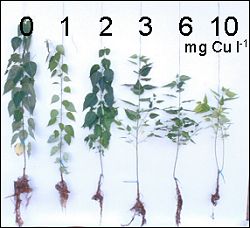Summary

Summary
Tree survival, growth and physiological function can be affected detrimentally by many contaminants. The upper critical concentration at which such effects take place varies for both tree species and contaminant. However, our research together with other published data clearly show that trees can survive contaminant levels far greater than those laid down in current guidelines, in both treated and non-treated soils:
- High concentrations of potentially toxic elements (PTEs) affect root growth. Roots typically accumulate significantly higher amounts of metals than the above-ground biomass.
- Lead, arsenic, cobalt, chromium, mercury, and tin remain mainly in the root system whilst copper, nickel, and selenium have an intermediate mobility.
Research overview
Our research is focusing on determining optimum species choice for planting in metal contaminated soils. We have developed models of metal (lead, copper, cadmium, zinc) tolerance for a range of tree species and are currently field testing whether these models are robust enough to make predictions of species suitability at a site specific level.
General Content
Publications
Gadepalle, V. P., S. K. Ouki, R. van Herwijnen and T. R. Hutchings (2007). Immobilisation of heavy metals in soil using natural and waste materials for vegetation establishment on contaminated sites. Soil and Sediment Contamination, 16(2), 233-251.
Harbottle, M. J., M. D. Mantle, M. L. Johns, R. van Herwijnen, A. Al-Tabbaa, T. Hutchings, A. Moffat and S. K. Ouki (2007). Magnetic resonance imaging of the effect of zeolite on lithium uptake in poplar. Environmental Science & Technology 41, 3444-3448.
van Herwijnen, R., A. Al-Tabbaa, T. R. Hutchings, A. J. Moffat, S. K. Ouki and M. L. Johns (2007). The impact of waste compost-based soil amendments on the leaching behaviour of a heavy metal contaminated soil. Environmental Engineering Science 24(7), 900-907.
van Herwijnen, R., T. R. Hutchings, A. Al-Tabbaa, A. J. Moffat, M. L. Johns and S. K. Ouki (2007). Remediation of metal contaminated soil with mineral-amended composts. Environmental Pollution 150(2), 347-354.
van Herwijnen, R., T. Laverye, J. Poole, M. E. Hodson and T. R. Hutchings (2007). The effect of organic materials on the mobility and toxicity of metals in contaminated soils. Applied Geochemistry 22(11), 2422-2434.
Gadepalle, V. P., S. K. Ouki, R. van Herwijnen and T. Hutchings (2008). Effects of amended compost on mobility and uptake of arsenic by rye grass in contaminated soil. Chemosphere 72(7), 1056-1061.
van Herwijnen, R., S. K. Ouki, A. Al-Tabbaa, A. Moffat, M. L. Johns and T. Hutchings (2008). The effect of two different composts on the performance and metal uptake of poplar growing on heavy metal contaminated soil. SEESOIL 17.
Contact
Related services
Funding & Partners
-
 Forestry Commission
Forestry Commission
